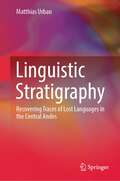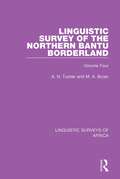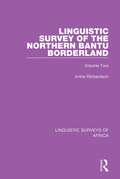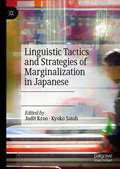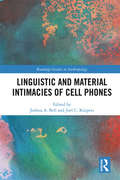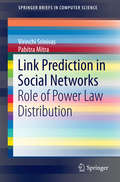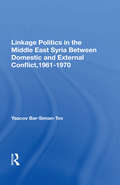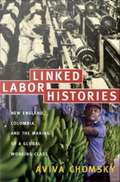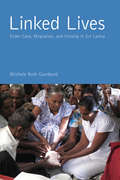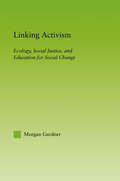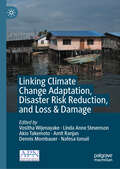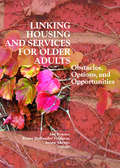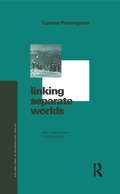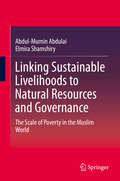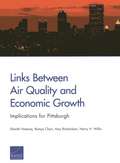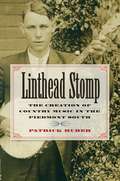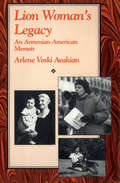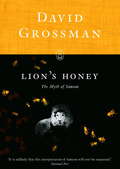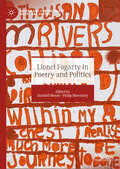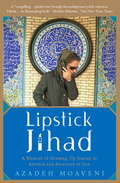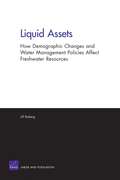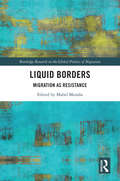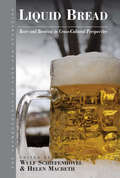- Table View
- List View
Linguistic Stratigraphy: Recovering Traces of Lost Languages in the Central Andes
by Matthias UrbanThis book examines the historical linguistic panorama of Western South America, focusing on the minor languages that were partially or fully replaced by the expansion of the Quechuan family through the region.The author presents a coherent and generally applicable framework for studying prehistoric language shift processes and reconstructing earlier linguistic landscapes before significant language spreads ousted former patterns of linguistic diversity. This framework combines toponymic evidence with the analysis of substrate contact effects, and, in some cases, extralinguistic evidence, to create an integrated if incomplete of extinct and undocumented languages. In an authoritative exploration of case studies, concerning Aymara in parts of Southern Peru, Cañar in Ecuador, and Chacha in Northern Peru, the book shows how the identities of lost languages and earlier linguistic panoramas can be reconstructed.
Linguistic Survey of the Northern Bantu Borderland: Volume Four (Linguistic Surveys of Africa #9)
by M. A. Bryan A. N. TuckerThe classification and distribution of the languages of the Northern Bantu Borderland between the Great Lakes and the Indian Ocean have been given in Volume 1 of The Linguistic Survey of the Northern Bantu Borderland, where however, the linguistic evidence on which the classification rested was not included. This is now set out in this volume, originally published in 1957. The languages have been divided into three categories: Bantu, partly Bantu and non-Bantu. within each category the languages have been grouped according to linguistic criteria. The choice of languages represented here has been determined by the availability of reliable linguistic material.
Linguistic Survey of the Northern Bantu Borderland: Volume One (Linguistic Surveys of Africa #7)
by A. N. Tucker Malcolm GuthrieThe northern limit of the Bantu languages is one of the important linguistic boundaries of Africa and this and the subsequent 3 volumes provide an invaluable resource which delimits the frontier. Since a number of the languages investigated had not hitherto been recorded, while with others the published information was inadquate and confused the Linguistic Survey of the Northern Bantu Borderland can justifiably be described as a pioneering study. This volume consists of demographic information together with maps and tabulated indications of the affinities of the languages.
Linguistic Survey of the Northern Bantu Borderland: Volume Two (Linguistic Surveys of Africa #8)
by Irvine RichardsonThis volume, originally published in 1957, contains the linguistic evidence for the classification of the languages encountered by the western team of the Northern Bantu Borderland Survey. To appreciate fully its implications it should be read in close conjunction with the appropriate sections of Volume 1 of the Survey, dealing with the demography of this area. The inclusion of some languages over others in this volume in no way reflects its demographic or linguistic importance, but simply indicates that the evidence was available to the Survey. The material is original and except where otherwise indicated was taken down by the team in phonetic script from local informants in situ.
Linguistic Tactics and Strategies of Marginalization in Japanese
by Judit Kroo Kyoko SatohThis edited book brings together studies on different aspects of marginalization in Japanese, creating a framework for studying marginalization which can also be applied in other linguistic and international contexts. The chapters in this book look at both marginalization of others and self-marginalization, examining the pragmatic strategies used to achieve marginalization, and investigating situations where it acts as an agentive tactic of speakers, in addition to a strategy of broader social structures. This book will be of interest to students and scholars of sociolinguistics, pragmatics, linguistic anthropology, and East Asian languages and cultures.
Linguistic and Material Intimacies of Cell Phones
by Joshua A. Bell Joel C. KuipersLinguistic and Material Intimacies of Cell Phones offers a detailed ethnographic and anthropological examination of the social, cultural, linguistic and material aspects of cell phones. With contributions from an international range of established and emerging scholars, this is a truly global collection with rural and urban examples from communities across the Global North and South. Linking the use of cell phones to contemporary discussions about representation, mediation and subjectivity, the book investigates how this increasingly ubiquitous technology challenges the boundaries of privacy and selfhood, raising new questions about how we communicate.
Link Prediction in Social Networks
by Virinchi Srinivas Pabitra MitraThiswork presents link prediction similarity measures for social networks that exploitthe degree distribution of the networks. In the context of link prediction indense networks, the text proposes similarity measures based on Markov inequalitydegree thresholding (MIDTs), which only consider nodes whose degree is above a thresholdfor a possible link. Also presented are similarity measures based on cliques(CNC, AAC, RAC), which assign extra weight between nodes sharing a greater numberof cliques. Additionally, a locally adaptive (LA) similarity measure isproposed that assigns different weights to common nodes based on the degreedistribution of the local neighborhood and the degree distribution of thenetwork. In the context of link prediction in dense networks, the textintroduces a novel two-phase framework that adds edges to the sparse graph toforma boost graph.
Linkage Politics In The Middle East: Syria Between Domestic And External Conflict, 1961-1970
by Yaacov Bar-siman-tovTraditional studies of linkage politics tend to assume that internal political instability leads a government to divert attention from internal problems by initiating an external conflict or stressing the pressures of international problems. In contrast, quantitative studies typically conclude that there is little or no relationship between interna
Linked Labour Histories: New England, Colombia, and the Making of a Global Working Class
by Aviva ChomskyExploring globalization from a labor history perspective, Aviva Chomsky provides historically grounded analyses of migration, labor-management collaboration, and the mobility of capital. She illuminates the dynamics of these movements through case studies set mostly in New England and Colombia. Taken together, the case studies offer an intricate portrait of two regions, their industries and workers, and the myriad links between them over the long twentieth century, as well as a new way to conceptualize globalization as a long-term process. Chomsky examines labor and management at two early-twentieth-century Massachusetts factories: one that transformed the global textile industry by exporting looms around the world, and another that was the site of a model program of labor-management collaboration in the 1920s. She follows the path of the textile industry from New England, first to the U. S. South, and then to Puerto Rico, Japan, Mexico, Central America, the Caribbean, and Colombia. She considers how towns in Rhode Island and Massachusetts began to import Colombian workers as they struggled to keep their remaining textile factories going. Most of the workers eventually landed in service jobs: cleaning houses, caring for elders, washing dishes. Focusing on Colombia between the 1960s and the present, Chomsky looks at the Urab banana export region, where violence against organized labor has been particularly acute, and, through a discussion of the AFL-CIO's activities in Colombia, she explores the thorny question of U. S. union involvement in foreign policy. In the 1980s, two U. S. coal mining companies began to shift their operations to Colombia, where they opened two of the largest open-pit coal mines in the world. Chomsky assesses how different groups, especially labor unions in both countries, were affected. Linked Labor Histories suggests that economic integration among regions often exacerbates regional inequalities rather than ameliorating them.
Linked Lives: Elder Care, Migration, and Kinship in Sri Lanka (Global Perspectives on Aging)
by Michele Ruth GamburdWhen youth shake off their rural roots and middle-aged people migrate for economic opportunities, what happens to the grandparents left at home? Linked Lives provides readers with intimate glimpses into homes in a Sri Lankan Buddhist village, where elders wisely use their moral authority and their control over valuable property to assure that they receive both physical and spiritual care when they need it. The care work that grandparents do for grandchildren allows labor migration and contributes to the overall well-being of the extended family. The book considers the efforts migrant workers make to build and buy houses and the ways those rooms and walls constrain social activities. It outlines the strategies elders employ to age in place, and the alternatives they face in local old folks’ homes. Based on ethnographic work done over a decade, Michele Gamburd shows how elders face the challenges of a rapidly globalizing world.
Linking Activism: Ecology, Social Justice, and Education for Social Change (New Approaches in Sociology)
by Morgan GardnerThis book, a unique examination of the activist striving to work for more holistic social change, creates a conceptual framework to give visibility to the complexity of activist practice that spans environmental and social justice concerns.
Linking Climate Change Adaptation, Disaster Risk Reduction, and Loss & Damage
by Linda Anne Stevenson Amit Ranjan Dennis Mombauer Vositha Wijenayake Akio Takemoto Nafesa IsmailThis book advances knowledge on loss & damage (L&D) and its interlinkages with climate adaptation and disaster risk reduction. The book includes twelve case studies conducted across South and Southeast Asia, covering sectors including agriculture, rural livelihoods, energy, infrastructure and natural resources. These studies provide insights into complex climate-induced L&D, enhancing local, national and regional knowledge and contributing to global agendas.
Linking Housing and Services for Older Adults: Obstacles, Options, and Opportunities
by Jon Pynoos Penny Hollander Feldman Joann AhrensPackaging supportive services with housing-a pressing issue for older adultsThe population of older adults is expected to explode in the coming years. Linking Housing and Services for Older Adults: Obstacles, Options, and Opportunities examines a crucial, complex, and often overlooked issue for policymakers and the public at large: older adults&’ increasing needs for housing and supportive long-term care services. As baby boomers strive to help their parents make difficult decisions about their options, pressure mounts for policymakers to develop appropriate housing and services. This book brings together respected experts to discuss the answers to difficult questions about meeting the housing and support service needs of aging adults.Linking Housing and Services for Older Adults: Obstacles, Options, and Opportunities explores in-depth the tough issues pertaining to which populations are presently being served, what their needs are, and who is being left out. You&’ll learn exactly what types of services are available, who is providing them, and how are they packaged. From residential care to assisted living to institutional care, this book addresses all facets of the complicated problems of providing availability to fulfill need. This important source presents insightful analysis of the total range of issues and the challenges to progress as well as offering specific recommendations to effectively offer housing and vital long-term care supportive services to older adults.Linking Housing and Services for Older Adults: Obstacles, Options, and Opportunities discusses in detail: the argument for increased development of supportive housing for older adults-and the barriers preventing it the issues related to providing a variety of housing and service options to the Medicaid population two case studies that illustrate how policies aimed at linking housing and services play out at the state and local level-and the need for strong leadership and the ability to develop key partnerships as vital aspects for success the interrelationship of factors regarding nursing home admission, the availability of subsidized housing, and Medicaid eligibility the need for care management to be holistic-including environmental care assessment, repair, and renovation management in addition to current long-term care settings creating affordable assisted living facilities for older persons receiving Medicaid services the successful components of the national Coming Home Program four case studies emphasizing different finance and regulatory approaches-providing lessons learned for developers, state agencies, and advocates of affordable assisted livingThis vital educational resource is also an essential reference for local, state, and national policymakers, housing officials, and long-term care providers.
Linking Separate Worlds: Urban Migrants and Rural Lives in Peru (Explorations in Anthropology)
by Karsten PaerregaardThis pathbreaking ethnography of population movements between rural and urban places in Peru addresses the conceptual and methodological problems of studying ‘deterritorialized' populations and the implications of this for anthropology's notions of culture and identity. Based on extensive fieldwork, this book explores the economic, social and ritual bonds which link migrants in Peru's major cities to their Andean native village. Many urban migrants establish networks based on kinship and marriage ties to exploit resources in the city as well as the village. These networks ensure they maintain strong links to their native village. Fiestas, soccer tournaments and folklore festivals also play a crucial role in the formation of migrant communities in Peru's cities. The author analyses these performance practices and shows how they give rise to the creation of new social identities. The participation of second generation migrants, returning migrants, and migrant spouses in village life is also discussed.
Linking Sustainable Livelihoods to Natural Resources and Governance
by Abdul-Mumin Abdulai Elmira ShamshiryThis book investigates the current level and trend of poverty in the Muslim World, including selected countries in Africa, the Middle East and Central Asia, East Asia, the Pacific and South America. Authors explore themes of poverty reduction, poverty alleviation and the extent of influences on social and economic development, particularly natural resource endowments (especially mineral resources) and their utilization. Chapters explore theory and practice, including governance and programmes, and take a detailed look at Zakat as a faith-based policy tool, to reduce poverty and improve livelihoods and thus contribute to better environmental stewardship. The final chapters look at development questions in the Muslim World and make policy recommendations, including a proposed multi-dimensional development collaboration model called the Development Collaboration Octagon Model (DeCOM). Readers will discover theoretical explanations of poverty and how poverty hampers the development of many nations because the poor are unable to partake actively in the development process. Poverty indicators and measurement are discussed, and trends of economic growth including productivity, manufacturing, trade patterns, investment and saving activity, and socio-economic developments are all explored: supporting data is presented in tables and figures, throughout this text. Authors explore the potency and success stories of public poverty alleviation strategies and programmes pursued in the Muslim world, especially the extent to which the institution of Zakat has been effectively incorporated into public poverty alleviation strategies. Policy options required to enhance social and economic development are proposed, to help pull the poor out of the poverty trap into the mainstream economy in the Muslim world. This work will appeal to anyone wishing to scrutinise poverty, its parameters and its relationship with the development of countries in the Muslim world. Scholars in the fields of economics, sociology, geography and Islamic studies will all find something of value here.
Links Between Air Quality and Economic Growth: Implications for Pittsburgh
by Henry H. Willis Amy Richardson Shanthi Nataraj Ramya ChariThis report assesses the evidence that exists for the ways in which local air quality could influence local economic growth through health and workforce issues, quality-of-life issues, or air-quality regulations and business operations. It then extrapolates some of the existing results to the Pittsburgh region.
Linthead Stomp
by Patrick HuberContrary to popular belief, the roots of American country music do not lie solely on southern farms or in mountain hollows. Rather, much of this music recorded before World War II emerged from the bustling cities and towns of the Piedmont South. No group contributed more to the commercialization of early country music than southern factory workers. In Linthead Stomp, Patrick Huber explores the origins and development of this music in the Piedmont's mill villages. Huber offers vivid portraits of a colorful cast of Piedmont millhand musicians, including Fiddlin' John Carson, Charlie Poole, Dave McCarn, and the Dixon Brothers, and considers the impact that urban living, industrial work, and mass culture had on their lives and music. Drawing on a broad range of sources, including rare 78-rpm recordings and unpublished interviews, Huber reveals how the country music recorded between 1922 and 1942 was just as modern as the jazz music of the same era. Linthead Stomp celebrates the Piedmont millhand fiddlers, guitarists, and banjo pickers who combined the collective memories of the rural countryside with the upheavals of urban-industrial life to create a distinctive American music that spoke to the changing realities of the twentieth-century South.
Lion Woman's Legacy: An Armenian-American Memoir (The\cross-cultural Memoir Ser.)
by Arlene Voski AvakianA &“vivid and engrossing&” narrative of one woman&’s journey from shame and internal conflict to becoming a liberated, confident, and proud lesbian (Kirkus Reviews). The descendant of survivors of the Armenian genocide, Arlene Avakian was raised in America where she could live free. But even with that freedom, she found herself a prisoner of both her family and society, denying her heritage along with her true sexuality. After marriage and motherhood, Arlene found herself exploring the growing women&’s lib movement of the 1970s, coming to embrace the strength of her grandmother—known as the Lion Woman—and realizing her full potential and personhood. Inspired by her passionate feminism and strengthened by a loving lesbian relationship, Avakian recollects and re-examines her personal history and the story of her courageous grandmother, revealing a legacy of radical politics, fierce independence, and a powerful affirmation of ethnic identity in this &“extremely readable and often painfully honest book&” (Library Journal).
Lion's Honey
by David GrossmanA consideration of one of the Bible's most powerful stories from a leading Israeli writer In this fascinating reexamination of the story of Samson, David Grossman goes beyond the surface of the familiar tale to look into what the life of this extraordinary man must have been like. What it felt like to have been "chosen" to release his people from the yoke of the Philistines, and yet alienated from them by his very otherness; what moved him to his acts of wild vandalism and his self-destructive passions; why he chose to keep some things secret, but not the most significant secret of all. We are left with the troubling knowledge that Samson bore too heavy a burden even for a man of his supernatural strength to bear alone."There are few other Bible stories with so much drama and action, narrative fireworks and raw emotion, as we find in the tale of Samson: the battle with the lion; the three hundred burning foxes; the women he bedded and the one woman that he loved; his betrayal by all the women in his life, from his mother to Delilah; and, in the end, his murderous suicide, when he brought the house down on himself and three thousand Philistines. Yet beyond the wild impulsiveness, the chaos, the din, we can make out a life story that is, at bottom, the tortured journey of a single, lonely and turbulent soul who never found, anywhere, a true home in the world, whose very body was a harsh place of exile. For me, this discovery, this recognition, is the point at which the myth - for all its grand images, its larger-than-life adventures - slips silently into the day-to-day existence of each of us, into our most private moments, our buried secrets."-from David Grossman's introduction to Lion's HoneyFrom the Hardcover edition.
Lionel Fogarty in Poetry and Politics (Modern and Contemporary Poetry and Poetics)
by Dashiell Moore Philip MorrisseySince the publication of his first poetry collection Kargun in 1980, Lionel Fogarty has produced some of the most complex, playful and strident poems written in English, and has been regarded by some as the greatest Aboriginal Australian poet of his generation. While over the course of his career, Fogarty has had relatively little recognition in awards or grants, recent attention to his work suggests a new turn in how his poetry is read and understood in Australia and overseas. Emerging from these conversations, Lionel Fogarty in Poetry and Politics illuminates the craft and art of Fogarty’s poetry in hand with his political activism in order to open his work for new readers and researchers. Bringing together a wide range of critical and creative voices in the first book-length study of Fogarty’s work, this essay collection represents a landmark moment for the study of Indigenous studies, poetry and poetics, Australian literature, and for future work on Fogarty’s poetry.
Lipstick Jihad: A Memoir of Growing up Iranian in America and American in Iran
by Azadeh MoaveniAs far back as she can remember, Azadeh Moaveni has felt at odds with her tangled identity as an Iranian-American. In suburban America, Azadeh lived in two worlds. At home, she was the daughter of the Iranian exile community, serving tea, clinging to tradition, and dreaming of Tehran. Outside, she was a California girl who practiced yoga and listened to Madonna. For years, she ignored the tense standoff between her two cultures. But college magnified the clash between Iran and America, and after graduating, she moved to Iran as a journalist. This is the story of her search for identity, between two cultures cleaved apart by a violent history. It is also the story of Iran, a restive land lost in the twilight of its revolution. Moaveni's homecoming falls in the heady days of the country's reform movement, when young people demonstrated in the streets and shouted for the Islamic regime to end. In these tumultuous times, she struggles to build a life in a dark country, wholly unlike the luminous, saffron and turquoise-tinted Iran of her imagination. As she leads us through the drug-soaked, underground parties of Tehran, into the hedonistic lives of young people desperate for change, Moaveni paints a rare portrait of Iran's rebellious next generation. The landscape of her Tehran -- ski slopes, fashion shows, malls and cafes -- is populated by a cast of young people whose exuberance and despair brings the modern reality of Iran to vivid life.
Lipstick Traces
by Greil MarcusGreil Marcus, author of Mystery Train, widely acclaimed as the best book ever written about America as seen through its music, began work on this new book out of a fascination with the Sex Pistols: that scandalous antimusical group, invented in London in 1975 and dead within two years, which sparked the emergence of the culture called punk. âeoeI am an antichrist!âe#157; shouted singer Johnny Rottenâe"where in the world of pop music did that come from? Looking for an answer, with a high sense of the drama of the journey, Marcus takes us down the dark paths of counterhistory, a route of blasphemy, adventure, and surprise. This is no mere search for cultural antecedents. Instead, what Marcus so brilliantly shows is that various kinds of angry, absolute demandsâe"demands on society, art, and all the governing structures of everyday lifeâe"seem to be coded in phrases, images, and actions passed on invisibly, but inevitably, by people quite unaware of each other. Marcus lets us hear strange yet familiar voices: of such heretics as the Brethren of the Free Spirit in medieval Europe and the Ranters in seventeenth-century England; the dadaists in Zurich in 1916 and Berlin in 1918, wearing death masks, chanting glossolalia; one Michel Mourre, who in 1950 took over Easter Mass at Notre-Dame to proclaim the death of God; the Lettrist International and the Situationist International, small groups of Parisâe"based artists and writers surrounding Guy Debord, who produced blank-screen films, prophetic graffiti, and perhaps the most provocative social criticism of the 1950s and âe(tm)60s; the rioting students and workers of May âe(tm)68, scrawling cryptic slogans on city walls and bringing France to a halt; the Sex Pistols in London, recording the savage âeoeAnarchy in the U. K. âe#157; and âeoeGod Save the Queen. âe#157;Although the Sex Pistols shape the beginning and the end of the story, Lipstick Traces is not a book about music; it is about a common voice, discovered and transmitted in many forms. Working from scores of previously unexamined and untranslated essays, manifestos, and filmscripts, from old photographs, dada sound poetry, punk songs, collages, and classic texts from Marx to Henri Lefebvre, Marcus takes us deep behind the acknowledged events of our era, into a hidden tradition of moments that would seem imaginary except for the fact that they are real: a tradition of shared utopias, solitary refusals, impossible demands, and unexplained disappearances. Written with grace and force, humor and an insistent sense of tragedy and danger, Lipstick Traces tells a story as disruptive and compelling as the century itself.
Liquid Assets
by Jill BobergMost writings linking demographic trends to water availability often look only at population-growth effects, treating water supplies as static and population as increasing, inexorably leading to a water-availability crisis. This report's more holistic view of the interaction between demographics and water resources considers more demographic and local water-availability variables. It focuses on conditions in developing countries, where these factors intersect with the fewest socioeconomic resources to mediate.
Liquid Borders: Migration as Resistance
by Mabel MorañaLiquid Borders provides a timely and critical analysis of the large-scale migration of people across borders, which has sent shockwaves through the global world order in recent years. In this book, internationally recognized scholars and activists from a variety of fields analyze key issues related to diasporic movements, displacements, exiles, "illegal" migrants, border crossings, deportations, maritime ventures, and the militarization of borders from political, economic, and cultural perspectives. Ambitious in scope, with cases stretching from the Mediterranean to Australia, the US/Mexico border, Venezuela, and deterritorialized sectors in Colombia and Central America, the various contributions are unified around the notion of freedom of movement, and the recognition of the need to think differently about ideas of citizenship and sovereignty around the world. Liquid Borders will be of interest to policy makers, and to researchers across the humanities, sociology, area studies, politics, international relations, geography, and of course migration and border studies.
Liquid Bread
by Helen Macbeth Wulf SchiefenhovelBeer is an ancient alcoholic drink which, although produced through a more complex process than wine, was developed by a wide range of cultures to become internationally popular. This book is the first multidisciplinary, cross-cultural collection about beer. It explores the brewing processes used in antiquity and in traditional societies; the social and symbolic roles of beer-drinking; the beliefs and activities associated with it; the health-promoting effects as well as the health-damaging risks; and analyses the modern role of large multinational companies, which own many of the breweries, and the marketing techniques that they employ.
